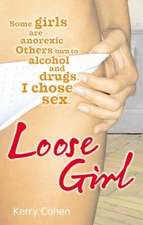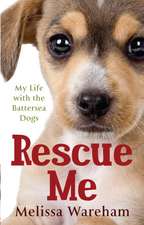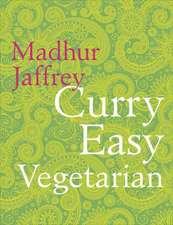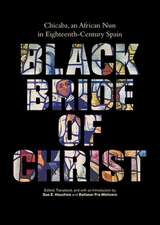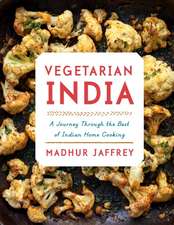Climbing the Mango Trees: A Memoir of a Childhood in India
Autor Madhur Jaffreyen Limba Engleză Paperback – 30 sep 2007
This memoir is both an enormously appealing account of an unusual childhood and a testament to the power of food to prompt memory, vividly bringing to life a lost time and place. Included here are recipes for more than thirty delicious dishes that are recovered from Jaffrey’s childhood.
Preț: 88.60 lei
Nou
Puncte Express: 133
Preț estimativ în valută:
16.97€ • 17.48$ • 14.24£
16.97€ • 17.48$ • 14.24£
Carte indisponibilă temporar
Doresc să fiu notificat când acest titlu va fi disponibil:
Se trimite...
Preluare comenzi: 021 569.72.76
Specificații
ISBN-13: 9781400078202
ISBN-10: 1400078202
Pagini: 297
Ilustrații: 36 PHOTOS
Dimensiuni: 134 x 202 x 17 mm
Greutate: 0.3 kg
Editura: Vintage Books USA
ISBN-10: 1400078202
Pagini: 297
Ilustrații: 36 PHOTOS
Dimensiuni: 134 x 202 x 17 mm
Greutate: 0.3 kg
Editura: Vintage Books USA
Notă biografică
Regarded by many as the world authority on Indian food, Madhur Jaffrey is an award-winning actress and best-selling cookbook author. Her classic first book, An Invitation to Indian Cooking, was published by Knopf in 1973, and she has been the host of a series, "Madhur Jaffrey's Indian Cookery," for BBC television. She has appeared in more than 20 films, including Merchant Ivory's Heat and Dust, and written more than 15 books. She won James Beard Awards in 1982, 1994, 2000, 2002, and 2004. She lives in New York City.
Extras
Ground Lamb with Peas (Keema Matar)
Serves 4ߝ6
I cannot imagine our picnics or train rides in India without this dish. For my grandchildren, growing up in America, it is an all-time favorite. Sometimes we eat it with pooris, the deep-fried puffed breads, as we did so often in India, and sometimes with rice. When cooking for the children, I leave out all the chilies, whether the powdered red kind or the fresh green variety. My parents did the same for us when we were growing up.
I use low-fat yogurt, but you may use whole-milk yogurt if you prefer.
1 cup plain yogurt
1/2 teaspoon ground turmeric
1 teaspoon ground cumin
1 tablespoon ground coriander
1 1/4 teaspoons salt
One 2-inch piece fresh ginger, peeled and grated to a pulp
3 good-sized cloves garlic, peeled and crushed to a pulp
2 pounds ground lamb
4 tablespoons peanut or olive oil
2 sticks cinnamon, about 2 inches each in length
4 whole cardamom pods
2 bay leaves
1 medium onion, peeled and finely chopped
1/2 cup puréed tomatoes (also labeled strained tomatoes or passata)
1 1/2 cups fresh (or frozen and defrosted) peas
3 tablespoons finely chopped fresh cilantro
1ߝ2 finely chopped fresh bird's eye or cayenne-type green chiles
1 teaspoon garam masala (see recipe below)
Put the yogurt in a bowl and whisk lightly until smooth and creamy. Add the turmeric, cayenne, cumin, coriander, salt, ginger, and garlic. Mix until well blended.
Put the lamb into a large bowl. Pour the yogurt mixture over the top and mix (I use my hands) until thoroughly blended. There should not be any pools of yogurt left.
Pour the oil into a large (preferably nonstick) sauté pan and set over medium-high heat. When it is hot, put in the cinnamon, cardamom, and bay leaves. Stir once or twice, and then add the onion. Stir and fry about 5 minutes, or until the onion pieces are reddish brown.
Add all the meat. Stir and cook, breaking up the meat until no lumps and no pinkness are left, about 5 minutes.
Add the tomato purée and stir it in. Bring to a simmer. Cover, turn the heat to medium-low, and cook for 30 minutes, stirring every 6ߝ7 minutes and making sure there is enough liquid so the lamb does not stick to the bottom. Uncover. Most of the liquid should have evaporated by this time. Stir and fry the meat for the next 5 minutes, removing and discarding the cinnamon sticks, cardamom pods, and bay leaves. After 5 minutes, spoon out as much of the fat as you can and discard it. Now put in the peas, cilantro, green chilies (if desired), garam masala, and 6 tablespoons water. Mix, cover and cook on low heat another 6ߝ7 minutes, or until tender.
Garam Masala
Makes about 3 tablespoons
An aromatic spice mixture made with the more expensive "warming" spices, this is generally, though not always, used towards the end of a cooking period to add a rich but still delicate whiff of elegance. It may be bought, already prepared, in spice stores, but generally has too many filler spices such as cumin and coriander and not enough of the more expensive cardamom and cinnamon. Indian grocers sell cardamom seeds already removed from their pods. Nutmegs are soft and may be broken by tapping with a hammer. Here is a family recipe.
1 tablespoon cardamom seeds
1 teaspoon whole black peppercorns
1 teaspoon whole black cumin seeds
1 teaspoon whole cloves
About 2/3 of a nutmeg
One 2-inch stick of cinnnamon, broken up into small pieces
Put all the spices into the container of a spice grinder or clean coffee grinder and grind as finely as possible. Store in a tightly lidded jar, away from sunlight. It will keep for several months.
ONE
The orchard site had housed our family homestead only since the early decades of the twentieth century. My family actually came from the walled city, often called Old Delhi, just to the south, built by the Moghul Emperor Shah Jahan in the seventeenth century. My family referred to it simply as Shahar, or the City.
There are many Delhis, as we were to study in school, all built either alongside each other or wholly or partly on top of each other, often reusing building materials knocked down in bloody efforts at domination. Our own original family home was in Chailpuri, in the narrow lanes of the Old City. It had as its carefully chosen foundation sturdy stones “borrowed” from the walls of Ferozshah Kotla, the fourteenth-century fortress and palace of a fourteenth- century emperor in a fourteenth-century Delhi.
Starting with the ancient Vedic city of Indraprastha, which flourished in the fifteenth century B.C., a succession of Delhis was built, first by generations of Hindu rajas, only to be followed in A.D. 1193 by a roll call of Muslim dynasties: Ghori, Ghaznavi, Qutubshahi, Khilji, Tughlak, Lodhi, and Moghul. They seemed to trust the dubious comfort of walled cities, and their leaders chose to name Delhi, again and again, after themselves. This ended, at least from the point of view of my childhood, with the British version, sans walls, New Delhi, designed by Sir Edwin Lutyens and built in the ruin- filled wilderness south of the Old City walls.
The Moghul capital, Shahjahanabad, or the Old City or the City, or Shahar, was where the written history of my family began. We were only blessed with our paternal side of it. My mother’s side either kept few records or humbly kept its accomplishments under wraps. This written history, bound in red, was kept in my grandfather’s home office.
When my grandfather—Babaji, as we called him—decided to move out of the City to the orchard estate, he was already a very successful barrister. His new house, the one in which I was born, was a brick- and-plaster version of a multi-roomed, grand Moghul tent with bits of British fortress and Greco-Roman classicism thrown in to hint vaguely at grandeur. The road it was built on was named after my grandfather, Raj Narain Road (with the patriotic Hindification of names that followed Independence, it is now Raj Narain Marg), and had the number 7 on its front gate. From the time I can remember, we always referred to that house as Number 7, as in “I’m going to Number 7,” or “You know that big tamarind tree in Number 7. . . .”
Not wishing to waste money, and full of the brio of someone recently “England-returned” (he had been studying law in London), he designed it all himself. As the family story goes, it was at this time that the British had decided to move their capital from Calcutta to Delhi, and Lutyens was in the process of building the new capital, to be named New Delhi. Lutyens asked my grandfather to pick any piece of land in New Delhi and build on it—Lutyens might have designed the house himself had my grandfather asked—but my grandfather dismissed the whole idea, saying, “Who wants to live in that jungle?” Properties in “that jungle” are now worth as much as those in central London and midtown Manhattan.
Years later, having proceeded beyond my three score and ten years, I was awarded an honorary CBE (Commander of the British Empire) by Queen Elizabeth II in Washington, D.C., another city designed by Lutyens, in a house also designed by Lutyens, the British ambassador’s residence. As I stared at my reflection there in a pair of dark Lutyens mirrors, dotted with glass rosettes, I couldn’t help thinking that my life might have come full-circle. I could have been born in a Lutyens house and received a grand recognition of my life in a Lutyens house. But I was not destined for such easy symmetry, for easy anything.
Babaji’s whitewashed house consisted of a central “gallery”—a hall, really—leading to five very large rooms with fireplaces. One of these was the drawing room, and the others served as bedrooms, one to a family. Running along the front and back of the house were two long verandas lined with semi-classical, semiߝGreco-Roman pillars. The back, east-facing veranda looked out on the Yamuna River, or, as we called it with great familiarity, the Jumna River. It was here that so many of us, as infants, were rubbed with oil and left to absorb the morning sun. Because the land must have sloped down to the water, this veranda was one floor up, built over a very large, partially underground, damp, always cool cellar or taikhana. My grandfather used to make wine here from grapes he imported from Afghanistan, but that must have been before I was born.
The front, west veranda faced the gardens, which had incorporated the remnants of the old orchard and now included a winding drive to the front gate. The front and back verandas ended in rooms at each corner of the house, the front ones being shaped somewhat like turrets. The functions of these corner rooms changed over the years, but one of them at the back, facing east and south, always remained my grandmother’s—and the family’s—chapel-like, Pooja ka Kamra or Prayer Room. On top of the house were two levels of flat roofs, the one in the center being higher, and both edged with a battlement-like balustrade.
But the main house was not large enough to fit the only army Babji was to see, a growing army of spirited grandchildren produced by his eight children. Some of these progeny lived at Number 7 all the time, and some came and went. Babaji firmly believed in the joint-family system, with himself presiding as the head of his brood, a system that had been followed by his father and grandfather and, indeed, by all his ancestors.
So, in addition to the main house and gardens, across two vast brick courtyards to the north and south of the main house, were two long, trainlike, one-room-wide annexes. Made of unpainted brick, they had a more casual, country feel. The one to the north started at the river end with the dining room and then went on to pantries, storage rooms, and the kitchen. Beyond it, across another bit of courtyard on the same north side, was the Boiler, industrial in size and used for making extra hot water for our winter baths, and an annex of bathrooms. The annex to the south, known simply as the Rooms (Kamras), also started at the river end. It contained my middle uncle’s bedroom and offices, then my grandfather’s offices, and then extra rooms for guests. Besides all this there was a shed for cows and horses, a servants’ annex, and two sets of large garages.
It was in my grandfather’s southern-annex office that I one day discovered, by complete chance, a book bound in red that was the family’s history. (I must have been thirteen at the time.)
There were actually two types of family history. There was the documented version that sat properly in my grandfather’s office. But there was also the undocumented version, consisting of fables, family customs, and hearsay passed along by my grandmother Bari Bauwa and the other women of the house. This version had begun seeping into us since birth, very subtly, with the honey on our tongues. And, to start with, it was the only one I knew.
Every autumn, at the religious festival of Dussehra, Bari Bauwa would demand that we bring all our writing implements to the Prayer Room. The men would be asked to bring their guns as well. She would arrange these in the altarlike temple she had set up—Parker pens, bottles of blue-black Quink, pencils, hunting rifles—all mixed in with gods, sacred threads, and marigolds. The women and children would gather inside the Prayer Room, with the men always hovering, unconvinced, by the doors. We would begin praying and sprinkling these rather ordinary implements with yellow turmeric powder, red roli powder, grains of rice, holy water, and flower petals. I thought then that all of India was doing what we were doing: asking blessings for pens and pencils and guns.
What I did not realize was that on that day most Hindus were asking God to bless the implements they worked with: farmers wanted blessings for their bulls and plows, and traders for their weights, measures, and coins.
But who were we, and why was my bottle of Quink in the Prayer Room? According to the women’s oral history—and this was never taught to us, just deduced slowly over time—we were a subcaste of Hindus known as Kayasthas: Mathur Kayasthas, to get the sub-subcaste right. Even as a child, I saw it so clearly in my imagination. . . . Roll the film: Ancient India. Day. A vast meeting of notables is being held on a mountainside to finalize the caste system. At the top of the heap, it is announced, are to be the self-satisfied priests, the Brahmins, who will be the only ones allowed the privilege of reading, writing, and making laws. There is much cheering from their quarter. Below them are to be the warriors, Kshatriyas, who will fight and rule kingdoms. This lot seems overjoyed, too. Lower on the totem pole will be the traders and farmers, Vaishyas, whose eyes glint at the thought of making money, and even further down, the menial workers or Shudras, who stand glum and silent.
The camera shifts. Next day. Night. A small hall lit with oil lamps. A smaller meeting of agitated intellectuals. They are overwrought because they are viscerally against all these categories. In any case, they do not fit neatly into any of them. Reading, writing, and making laws is what gives them the most satisfaction, but religious orthodoxy scares them, and they want none of it. They have no fear at all of ruling any part of the world, but they will not give up their precious books. They lack both the sort of entrepreneurial spirit that makes successful traders (in fact, hush, they look down on traders), and the physical strength and desperation that sustain farmers. So they vote rather boldly to form a union of their own, a separate subcaste of freethinking writer-warriors to be known as Kayasthas. The End.
That is my version of events. There is actually a real legend, if legends can be real, that goes something like this: Just after Brahma, the God of the Universe, had created the caste system with, in descending order, the Brahmins, Kshatriyas, Vaishyas, and Shudras, a worried Yama, God and Chief Justice of the Underworld, approached him, saying, “I need an assistant who has the ability to record the deeds of man, both good and evil, and to administer justice.” Brahma went into a trance. When he opened his eyes, he saw before him a glorious figure of a man holding a pen in one hand, an inkpot in another, and a sword tied around his waist. Brahma spoke: “Thou hast been created from my body [kaya], therefore thy progeny shall be known as Kayasthas. Thy work will be to dispense justice and punish those that violate Divine laws.” Brahma gave him the special caste of Dwij-Kshatriya, twice-born warrior.
Another such “history” lesson came directly from my grandmother. I will never forget the day.
It was one of those sunny but crisp, cold winter Sundays that Delhi loves. Winter lasted only two months a year, and our family turned quite British for this season. At least in our clothing. All the tweed coats and jackets (British fabrics, Indian tailors) and cardigans (British wool and patterns, family-women knitters) came out of mothballed trunks. They were spread out on the lawn and sunned repeatedly for days, in a desperate effort to rid them of their naphthalene odor, after which they were hung or folded up and put into cupboards. The women wore hand-knitted cardigans on top of their sarees and then bundled themselves further in Kashmiri shawls.
I was ten and looking smart as smart can be in my pale-blue herringbone-patterned woolen overcoat, made to measure at Lokenath’s in Connaught Place, New Delhi. (My two older sisters had exactly the same coats.) It was January, and so cold that we had to wear overcoats both inside and outside the house. I smelled of mothballs.
About twenty of us had barely collected in the dining-room annex for breakfast when the Lady in White arrived. Of the same age as my grandmother, she was habitually enshrouded in a long white skirt or lahanga, a white bodice, and a white covering over her head. Her skin color matched her clothing. I used to think that my mother was the whitest Indian I knew until I met the Lady in White. My mother was the color of cream. The Lady in White was the color of milk. What mattered most to us, though, was not her milky color but the milky ambrosia that she carried on her head.
Yes, balanced there, on a round brass tray, were dozens of mutkainas, terra-cotta cups, filled with daulat ki chaat, which could be translated as “a snack of wealth.” Some cynic who assumed that all wealth was ephemeral must have named it. It was, indeed, the most ephemeral of fairy dishes, a frothy evanescence that disappeared as soon it touched the tongue, a winter specialty requiring dew as an ingredient. Whenever I asked the Lady in White how it was made, she would sigh a mysterious sigh and say, “Oh, child, I am one of the few women left in the whole city of Delhi who can make this. I am so old, and it is such hard work. What shall I tell you? I only go to all this trouble because I have served your grandmother from the time she lived in the Old City. First I take rich milk and add dried seafoam to it. Then I pour the mixture into nicely washed terra-cotta cups that I get directly from the potter. I have to climb up the stairs to the roof and leave the cups in the chill night air. Now, the most important element is the dew. If there is no dew, the froth will not form. If there is too much dew, that is also bad. The dew you have to leave to the gods. In the early morning, if the froth is good, I sprinkle the cups with a little sugar, a little khurchan [milk boiled down into thin, sweet, flaky sheets], and fine shavings of pistachios. That, I suppose, is it.”
Those cups were the first things placed before us at breakfast that day. Our spoons, provided by the Lady in White, were the traditional flat pieces of bamboo. Heavenly froth, tasting a bit of the bamboo, a bit of the terra-cotta, a bit sweet and a bit nutty—surely this was the food of angels.
From the Hardcover edition.
Serves 4ߝ6
I cannot imagine our picnics or train rides in India without this dish. For my grandchildren, growing up in America, it is an all-time favorite. Sometimes we eat it with pooris, the deep-fried puffed breads, as we did so often in India, and sometimes with rice. When cooking for the children, I leave out all the chilies, whether the powdered red kind or the fresh green variety. My parents did the same for us when we were growing up.
I use low-fat yogurt, but you may use whole-milk yogurt if you prefer.
1 cup plain yogurt
1/2 teaspoon ground turmeric
1 teaspoon ground cumin
1 tablespoon ground coriander
1 1/4 teaspoons salt
One 2-inch piece fresh ginger, peeled and grated to a pulp
3 good-sized cloves garlic, peeled and crushed to a pulp
2 pounds ground lamb
4 tablespoons peanut or olive oil
2 sticks cinnamon, about 2 inches each in length
4 whole cardamom pods
2 bay leaves
1 medium onion, peeled and finely chopped
1/2 cup puréed tomatoes (also labeled strained tomatoes or passata)
1 1/2 cups fresh (or frozen and defrosted) peas
3 tablespoons finely chopped fresh cilantro
1ߝ2 finely chopped fresh bird's eye or cayenne-type green chiles
1 teaspoon garam masala (see recipe below)
Put the yogurt in a bowl and whisk lightly until smooth and creamy. Add the turmeric, cayenne, cumin, coriander, salt, ginger, and garlic. Mix until well blended.
Put the lamb into a large bowl. Pour the yogurt mixture over the top and mix (I use my hands) until thoroughly blended. There should not be any pools of yogurt left.
Pour the oil into a large (preferably nonstick) sauté pan and set over medium-high heat. When it is hot, put in the cinnamon, cardamom, and bay leaves. Stir once or twice, and then add the onion. Stir and fry about 5 minutes, or until the onion pieces are reddish brown.
Add all the meat. Stir and cook, breaking up the meat until no lumps and no pinkness are left, about 5 minutes.
Add the tomato purée and stir it in. Bring to a simmer. Cover, turn the heat to medium-low, and cook for 30 minutes, stirring every 6ߝ7 minutes and making sure there is enough liquid so the lamb does not stick to the bottom. Uncover. Most of the liquid should have evaporated by this time. Stir and fry the meat for the next 5 minutes, removing and discarding the cinnamon sticks, cardamom pods, and bay leaves. After 5 minutes, spoon out as much of the fat as you can and discard it. Now put in the peas, cilantro, green chilies (if desired), garam masala, and 6 tablespoons water. Mix, cover and cook on low heat another 6ߝ7 minutes, or until tender.
Garam Masala
Makes about 3 tablespoons
An aromatic spice mixture made with the more expensive "warming" spices, this is generally, though not always, used towards the end of a cooking period to add a rich but still delicate whiff of elegance. It may be bought, already prepared, in spice stores, but generally has too many filler spices such as cumin and coriander and not enough of the more expensive cardamom and cinnamon. Indian grocers sell cardamom seeds already removed from their pods. Nutmegs are soft and may be broken by tapping with a hammer. Here is a family recipe.
1 tablespoon cardamom seeds
1 teaspoon whole black peppercorns
1 teaspoon whole black cumin seeds
1 teaspoon whole cloves
About 2/3 of a nutmeg
One 2-inch stick of cinnnamon, broken up into small pieces
Put all the spices into the container of a spice grinder or clean coffee grinder and grind as finely as possible. Store in a tightly lidded jar, away from sunlight. It will keep for several months.
ONE
The orchard site had housed our family homestead only since the early decades of the twentieth century. My family actually came from the walled city, often called Old Delhi, just to the south, built by the Moghul Emperor Shah Jahan in the seventeenth century. My family referred to it simply as Shahar, or the City.
There are many Delhis, as we were to study in school, all built either alongside each other or wholly or partly on top of each other, often reusing building materials knocked down in bloody efforts at domination. Our own original family home was in Chailpuri, in the narrow lanes of the Old City. It had as its carefully chosen foundation sturdy stones “borrowed” from the walls of Ferozshah Kotla, the fourteenth-century fortress and palace of a fourteenth- century emperor in a fourteenth-century Delhi.
Starting with the ancient Vedic city of Indraprastha, which flourished in the fifteenth century B.C., a succession of Delhis was built, first by generations of Hindu rajas, only to be followed in A.D. 1193 by a roll call of Muslim dynasties: Ghori, Ghaznavi, Qutubshahi, Khilji, Tughlak, Lodhi, and Moghul. They seemed to trust the dubious comfort of walled cities, and their leaders chose to name Delhi, again and again, after themselves. This ended, at least from the point of view of my childhood, with the British version, sans walls, New Delhi, designed by Sir Edwin Lutyens and built in the ruin- filled wilderness south of the Old City walls.
The Moghul capital, Shahjahanabad, or the Old City or the City, or Shahar, was where the written history of my family began. We were only blessed with our paternal side of it. My mother’s side either kept few records or humbly kept its accomplishments under wraps. This written history, bound in red, was kept in my grandfather’s home office.
When my grandfather—Babaji, as we called him—decided to move out of the City to the orchard estate, he was already a very successful barrister. His new house, the one in which I was born, was a brick- and-plaster version of a multi-roomed, grand Moghul tent with bits of British fortress and Greco-Roman classicism thrown in to hint vaguely at grandeur. The road it was built on was named after my grandfather, Raj Narain Road (with the patriotic Hindification of names that followed Independence, it is now Raj Narain Marg), and had the number 7 on its front gate. From the time I can remember, we always referred to that house as Number 7, as in “I’m going to Number 7,” or “You know that big tamarind tree in Number 7. . . .”
Not wishing to waste money, and full of the brio of someone recently “England-returned” (he had been studying law in London), he designed it all himself. As the family story goes, it was at this time that the British had decided to move their capital from Calcutta to Delhi, and Lutyens was in the process of building the new capital, to be named New Delhi. Lutyens asked my grandfather to pick any piece of land in New Delhi and build on it—Lutyens might have designed the house himself had my grandfather asked—but my grandfather dismissed the whole idea, saying, “Who wants to live in that jungle?” Properties in “that jungle” are now worth as much as those in central London and midtown Manhattan.
Years later, having proceeded beyond my three score and ten years, I was awarded an honorary CBE (Commander of the British Empire) by Queen Elizabeth II in Washington, D.C., another city designed by Lutyens, in a house also designed by Lutyens, the British ambassador’s residence. As I stared at my reflection there in a pair of dark Lutyens mirrors, dotted with glass rosettes, I couldn’t help thinking that my life might have come full-circle. I could have been born in a Lutyens house and received a grand recognition of my life in a Lutyens house. But I was not destined for such easy symmetry, for easy anything.
Babaji’s whitewashed house consisted of a central “gallery”—a hall, really—leading to five very large rooms with fireplaces. One of these was the drawing room, and the others served as bedrooms, one to a family. Running along the front and back of the house were two long verandas lined with semi-classical, semiߝGreco-Roman pillars. The back, east-facing veranda looked out on the Yamuna River, or, as we called it with great familiarity, the Jumna River. It was here that so many of us, as infants, were rubbed with oil and left to absorb the morning sun. Because the land must have sloped down to the water, this veranda was one floor up, built over a very large, partially underground, damp, always cool cellar or taikhana. My grandfather used to make wine here from grapes he imported from Afghanistan, but that must have been before I was born.
The front, west veranda faced the gardens, which had incorporated the remnants of the old orchard and now included a winding drive to the front gate. The front and back verandas ended in rooms at each corner of the house, the front ones being shaped somewhat like turrets. The functions of these corner rooms changed over the years, but one of them at the back, facing east and south, always remained my grandmother’s—and the family’s—chapel-like, Pooja ka Kamra or Prayer Room. On top of the house were two levels of flat roofs, the one in the center being higher, and both edged with a battlement-like balustrade.
But the main house was not large enough to fit the only army Babji was to see, a growing army of spirited grandchildren produced by his eight children. Some of these progeny lived at Number 7 all the time, and some came and went. Babaji firmly believed in the joint-family system, with himself presiding as the head of his brood, a system that had been followed by his father and grandfather and, indeed, by all his ancestors.
So, in addition to the main house and gardens, across two vast brick courtyards to the north and south of the main house, were two long, trainlike, one-room-wide annexes. Made of unpainted brick, they had a more casual, country feel. The one to the north started at the river end with the dining room and then went on to pantries, storage rooms, and the kitchen. Beyond it, across another bit of courtyard on the same north side, was the Boiler, industrial in size and used for making extra hot water for our winter baths, and an annex of bathrooms. The annex to the south, known simply as the Rooms (Kamras), also started at the river end. It contained my middle uncle’s bedroom and offices, then my grandfather’s offices, and then extra rooms for guests. Besides all this there was a shed for cows and horses, a servants’ annex, and two sets of large garages.
It was in my grandfather’s southern-annex office that I one day discovered, by complete chance, a book bound in red that was the family’s history. (I must have been thirteen at the time.)
There were actually two types of family history. There was the documented version that sat properly in my grandfather’s office. But there was also the undocumented version, consisting of fables, family customs, and hearsay passed along by my grandmother Bari Bauwa and the other women of the house. This version had begun seeping into us since birth, very subtly, with the honey on our tongues. And, to start with, it was the only one I knew.
Every autumn, at the religious festival of Dussehra, Bari Bauwa would demand that we bring all our writing implements to the Prayer Room. The men would be asked to bring their guns as well. She would arrange these in the altarlike temple she had set up—Parker pens, bottles of blue-black Quink, pencils, hunting rifles—all mixed in with gods, sacred threads, and marigolds. The women and children would gather inside the Prayer Room, with the men always hovering, unconvinced, by the doors. We would begin praying and sprinkling these rather ordinary implements with yellow turmeric powder, red roli powder, grains of rice, holy water, and flower petals. I thought then that all of India was doing what we were doing: asking blessings for pens and pencils and guns.
What I did not realize was that on that day most Hindus were asking God to bless the implements they worked with: farmers wanted blessings for their bulls and plows, and traders for their weights, measures, and coins.
But who were we, and why was my bottle of Quink in the Prayer Room? According to the women’s oral history—and this was never taught to us, just deduced slowly over time—we were a subcaste of Hindus known as Kayasthas: Mathur Kayasthas, to get the sub-subcaste right. Even as a child, I saw it so clearly in my imagination. . . . Roll the film: Ancient India. Day. A vast meeting of notables is being held on a mountainside to finalize the caste system. At the top of the heap, it is announced, are to be the self-satisfied priests, the Brahmins, who will be the only ones allowed the privilege of reading, writing, and making laws. There is much cheering from their quarter. Below them are to be the warriors, Kshatriyas, who will fight and rule kingdoms. This lot seems overjoyed, too. Lower on the totem pole will be the traders and farmers, Vaishyas, whose eyes glint at the thought of making money, and even further down, the menial workers or Shudras, who stand glum and silent.
The camera shifts. Next day. Night. A small hall lit with oil lamps. A smaller meeting of agitated intellectuals. They are overwrought because they are viscerally against all these categories. In any case, they do not fit neatly into any of them. Reading, writing, and making laws is what gives them the most satisfaction, but religious orthodoxy scares them, and they want none of it. They have no fear at all of ruling any part of the world, but they will not give up their precious books. They lack both the sort of entrepreneurial spirit that makes successful traders (in fact, hush, they look down on traders), and the physical strength and desperation that sustain farmers. So they vote rather boldly to form a union of their own, a separate subcaste of freethinking writer-warriors to be known as Kayasthas. The End.
That is my version of events. There is actually a real legend, if legends can be real, that goes something like this: Just after Brahma, the God of the Universe, had created the caste system with, in descending order, the Brahmins, Kshatriyas, Vaishyas, and Shudras, a worried Yama, God and Chief Justice of the Underworld, approached him, saying, “I need an assistant who has the ability to record the deeds of man, both good and evil, and to administer justice.” Brahma went into a trance. When he opened his eyes, he saw before him a glorious figure of a man holding a pen in one hand, an inkpot in another, and a sword tied around his waist. Brahma spoke: “Thou hast been created from my body [kaya], therefore thy progeny shall be known as Kayasthas. Thy work will be to dispense justice and punish those that violate Divine laws.” Brahma gave him the special caste of Dwij-Kshatriya, twice-born warrior.
Another such “history” lesson came directly from my grandmother. I will never forget the day.
It was one of those sunny but crisp, cold winter Sundays that Delhi loves. Winter lasted only two months a year, and our family turned quite British for this season. At least in our clothing. All the tweed coats and jackets (British fabrics, Indian tailors) and cardigans (British wool and patterns, family-women knitters) came out of mothballed trunks. They were spread out on the lawn and sunned repeatedly for days, in a desperate effort to rid them of their naphthalene odor, after which they were hung or folded up and put into cupboards. The women wore hand-knitted cardigans on top of their sarees and then bundled themselves further in Kashmiri shawls.
I was ten and looking smart as smart can be in my pale-blue herringbone-patterned woolen overcoat, made to measure at Lokenath’s in Connaught Place, New Delhi. (My two older sisters had exactly the same coats.) It was January, and so cold that we had to wear overcoats both inside and outside the house. I smelled of mothballs.
About twenty of us had barely collected in the dining-room annex for breakfast when the Lady in White arrived. Of the same age as my grandmother, she was habitually enshrouded in a long white skirt or lahanga, a white bodice, and a white covering over her head. Her skin color matched her clothing. I used to think that my mother was the whitest Indian I knew until I met the Lady in White. My mother was the color of cream. The Lady in White was the color of milk. What mattered most to us, though, was not her milky color but the milky ambrosia that she carried on her head.
Yes, balanced there, on a round brass tray, were dozens of mutkainas, terra-cotta cups, filled with daulat ki chaat, which could be translated as “a snack of wealth.” Some cynic who assumed that all wealth was ephemeral must have named it. It was, indeed, the most ephemeral of fairy dishes, a frothy evanescence that disappeared as soon it touched the tongue, a winter specialty requiring dew as an ingredient. Whenever I asked the Lady in White how it was made, she would sigh a mysterious sigh and say, “Oh, child, I am one of the few women left in the whole city of Delhi who can make this. I am so old, and it is such hard work. What shall I tell you? I only go to all this trouble because I have served your grandmother from the time she lived in the Old City. First I take rich milk and add dried seafoam to it. Then I pour the mixture into nicely washed terra-cotta cups that I get directly from the potter. I have to climb up the stairs to the roof and leave the cups in the chill night air. Now, the most important element is the dew. If there is no dew, the froth will not form. If there is too much dew, that is also bad. The dew you have to leave to the gods. In the early morning, if the froth is good, I sprinkle the cups with a little sugar, a little khurchan [milk boiled down into thin, sweet, flaky sheets], and fine shavings of pistachios. That, I suppose, is it.”
Those cups were the first things placed before us at breakfast that day. Our spoons, provided by the Lady in White, were the traditional flat pieces of bamboo. Heavenly froth, tasting a bit of the bamboo, a bit of the terra-cotta, a bit sweet and a bit nutty—surely this was the food of angels.
From the Hardcover edition.
Recenzii
“Wistful, funny and tremendously satisfying. . . . Jaffrey's taste memories sparkle with enthusiasm, and her talent for conveying them makes the book relentlessly appetizing.”
—The New York Times Book Review
“Do not attempt to read [this] mouth-wateringly evocative memoir on an empty stomach. . . . A delicious tribute to a deeply rooted, multicultural upbringing.”
—Newsday
“A sharp observer with a pleasing eye for sensual detail, Jaffrey weaves a richly textured story in which she effortlessly mingles quotidian drams with historic events.”
—People Magazine
"Her story reads like a novel and evokes images worthy of a Merchant-Ivoryproduction. You can practically taste sun warmed mangoes plucked from the tree, the barley-sugar candy that holds a hallowed place in the author's memory."
—The Seattle Times
—The New York Times Book Review
“Do not attempt to read [this] mouth-wateringly evocative memoir on an empty stomach. . . . A delicious tribute to a deeply rooted, multicultural upbringing.”
—Newsday
“A sharp observer with a pleasing eye for sensual detail, Jaffrey weaves a richly textured story in which she effortlessly mingles quotidian drams with historic events.”
—People Magazine
"Her story reads like a novel and evokes images worthy of a Merchant-Ivoryproduction. You can practically taste sun warmed mangoes plucked from the tree, the barley-sugar candy that holds a hallowed place in the author's memory."
—The Seattle Times
Descriere
From a highly regarded writer on Indian food comes this enchanting and delightful memoir of growing up in Delhi. An enormously appealing account of an unusual childhood, Jaffreys story is also a testament to the power of food to prompt memory.

